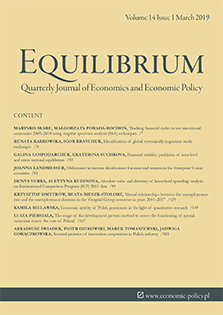Mutual relationships between the unemployment rate and the unemployment duration in the Visegrad Group countries in years 2001–2017
Mutual relationships between the unemployment rate and the unemployment duration in the Visegrad Group countries in years 2001–2017
Author(s): Krzysztof Dmytrów, Beata Bieszk-StolorzSubject(s): Business Economy / Management, Labor relations, Present Times (2010 - today)
Published by: Instytut Badań Gospodarczych
Keywords: registered unemployment rate; unemployment duration; business cycle clock; Dynamic Time Warping; Visegrad Group countries;
Summary/Abstract: Research background: The most important indicators that describe the situation on the labour market are the unemployment rate and the unemployment duration. If both these indicators are high, then the human capital deteriorates. Therefore, it seems justified to analyse the mutual relationships between them. Purpose of the article: The article aims at finding the relationships between the unemployment rate and the unemployment duration, and checking if the mutual courses of these two indicators in the Visegrad Group countries are connected with each other. Methods: The business cycle clock methodology will be used to analyse the relationship between the unemployment rate and the median unemployment duration. Next, the similarity of the course of these two indicators will be analysed by means of the Pearson product-moment correlation coefficient and the Dynamic Time Warping (DTW) technique. Findings & Value added: Amongst the analysed countries, Czechia, Poland and Slovakia were, to a certain degree, similar with respect to the mutual course of the unemployment rate and the unemployment duration. Until the peak of the financial crisis in 2009, the unemployment rate and the unemployment duration decreased. During the next years, the unemployment rate was increasing and after 2-3 years it was followed by the increase of the unemployment duration. The situation improved after the year 2013 — both indicators were decreasing. In Hungary, on the contrary, the unemployment rate was increasing or steady until 2012, and during the following years it started to decrease. However, the course of the unemployment duration was completely different than in remaining countries. The value added of the article is application of the business clock cycle and the Dynamic Time Warping technique in finding the relations hips and similarity of courses between the unemployment rate and the unemployment duration.
Journal: Equilibrium. Quarterly Journal of Economics and Economic Policy
- Issue Year: 14/2019
- Issue No: 1
- Page Range: 129-148
- Page Count: 20
- Language: English

